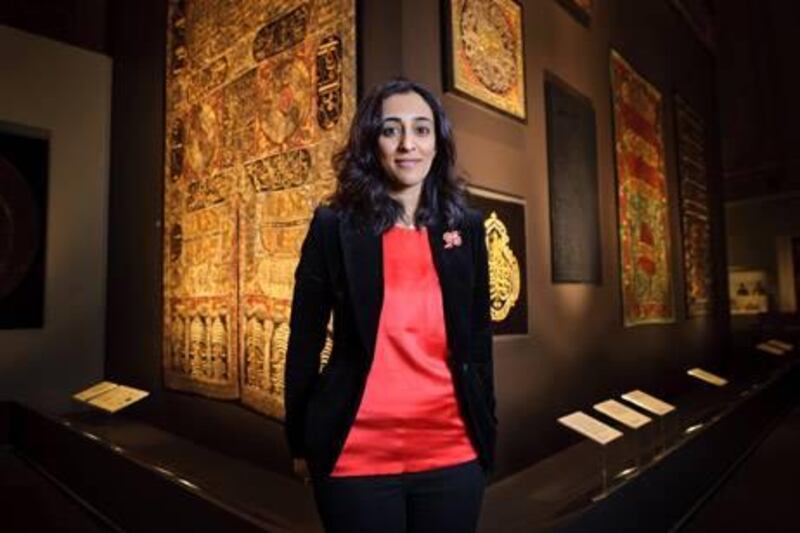In the half-light of the British Museum's Round Reading Room, I am waiting to talk to Qaisra Khan, the curator of a pioneering new exhibition about the Haj.
Our interview has been delayed twice as she is constantly called onto the exhibition floor for last-minute adjustments. Around me, museum staff scurry around the artefacts, checking they have been correctly positioned and that their labels are accurate.
We exchange pleasantries, and Khan expresses her delight at the positive reception the exhibition is getting worldwide. She is softly spoken, and each word is chosen with care. But beneath her precise manner of speech and her self-contained demeanour, I sense a deep-seated drive and creativity.
The thirty-something is passionate about her work, her eyes glittering as she describes how each exhibit was painstakingly procured from public and private collections around the world. But the arts wasn't a place Khan ever imagined her career would take her. Her parents had "set rules" about the kind of professions that were suitable for their children, a world view that is not unusual for Asian families such as Khan's. Doctors, lawyers and accountants were typical choices.
Of Pakistani descent, she grew up in Manchester, UK, the youngest of four children. One of her older siblings went to Oxford, the other, Cambridge. She followed by gaining her undergraduate degree in law from Magdalene College, Cambridge University. Law was her "sensible" choice.
It wasn't straight out into the world though. Between her degree and the workplace, the first hint of Khan's self-confessed unconventionality manifested itself.
She undertook a master's of philosophy degree in oriental studies at Cambridge. The mixture of arts, poetry and Persian literature lit a flame within her. "I wanted to do something completely different that I'd be really happy doing," she says.
MPhil completed, and head ruling heart, she took a "sensible job" in the city, at the international accountancy firm Deloitte. In the evenings she studied gemmology and Islamic art.
Five years later, she gave up her job to complete her legal studies. She acknowledges that "it would have been the easy option to plod along". She insists it was not bravery but practicality that led to her resignation from a prize job. She wanted to ensure she was fully qualified as a lawyer.
But she didn't take up a job as a lawyer; instead, she applied for and secured an extremely sought after internship at Christie's auction house. I'm baffled by this. Was it fate? She seems surprised by this idea. "I put myself out there," she says.
She had the right skills, along with passion and determination, and her business background was an asset. "I understood that Christie's is first and foremost a business," she says. Being self-taught in the arts was a bonus to demonstrate her commitment to the career change.
The six months she spent with Christie's were a "huge stepping stone", and there was no turning back. She then moved to the Museum of Islamic Art in Doha, where she was researching artefacts at the soon-to-be-opened establishment. The work was "incredibly exciting", with the opportunity to work on parts of the collection never seen before. The relationships she built with her co-workers made Doha, then still under construction, more bearable.
"I became very good at shopping, too," she says, chuckling.
Ultimately she returned to London to marry her fiancé, whom she had met at Deloitte. They now live in Northwood, north-west London. What does he think of her foray into the arts? "He's very proud," she says.
Newly married and unemployed for the first time since graduation, Khan at first enjoyed the rest. However, with no roles coming up, and the recession biting, she wondered "what have I done? Have I made a mistake?" But her risk-taking paid off when the British Museum advertised a role just under two years ago for project curator for the Haj exhibition.
"I almost cried when I got the job," Khan says. "It was like an Oscar speech."
From City finance to sensible law to pioneering arts: is it a struggle managing her seemingly contradictory pragmatism and creativity? Such internal conflict could be paralysing, but for Khan this tension propels her forward. She pauses, searching for the right response, careful neither to give away too much nor be vague.
"I'm a considered risk-taker," she says.
And what does she think of her journey?
"I had no clear vision," she muses, looking back to Cambridge, through to financial services, to Christie's, abroad to the Museum of Islamic Art in Doha and finally to where we are today at the British Museum. But then she laughs, and says her unusual route might not be so surprising after all.
"My father has a tagline," she explains: "Nothing is impossible."
Hajj - Journey to the Heart of Islam runs until April 15 at the British Museum in London. For more details go to www.britishmuseum.org.





